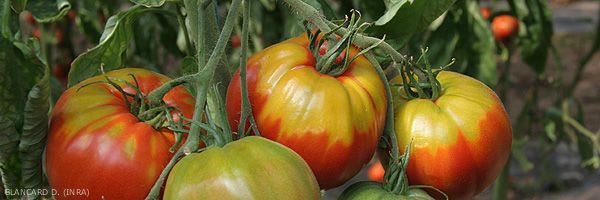
Green or yellow collar on fruits
( green or yellow shoulder, greenback )
( green or yellow shoulder, greenback )
- Symptoms on fruits
Darker coloration of the stalk area of green fruits. At maturity, this zone remains more or less green or gradually turns yellow and remains there. Ultimately, the fruit collars show a very characteristic and more or less sustained green (figures 1 and 2) or yellow (figures 3 to 5) color, either homogeneously or in the form of irregular spots. The pericarp of the affected areas is hard in consistency and sometimes white in color.
- Origin of damage
Non-parasitic disease
During the ripening of the fruits, the chlorophyll does not degrade or only too little in the affected areas. Several factors seem to favorably influence the expression of this physiological disease:
- high temperatures as they approach maturity;
- plants which are not very vegetative or too leafless, exposing the fruits to radiation;
- unbalanced fertilizations, especially low in potassium.
Placed under these conditions, the different cultivated tomato varieties do not express the same sensitivity. For example, cultivars with “ fruits uniform color ” are resistant. On the other hand, those of the “long shelf life” type show this defect quite easily.
- How to cure it
It suffices to manage as best as possible the parameters influencing the expression of this non-parasitic disease.
The plant and its behavior
- Cultivate varieties that are not very sensitive or resistant.
- Avoid excessive leaf stripping during the summer, especially on varieties with low vegetation.
- Provide good protection for the plants in order to prevent damage linked to various defoliating pests.
The climate
Launder the shelters early enough.
Ferti-irrigation
Ensure good potassium fertilization.





